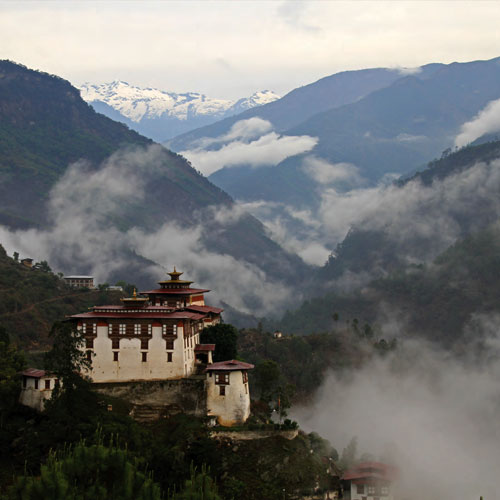Bhutan remained isolated from the rest of the world and no tourism existed until 1974 preserving the rich natural environment and lively Buddhist culture. Today Bhutan has become one of the most exotic destinations for many international travelers.
History
Bhutan has never been colonized. The written records of its past go back to the 8th century when the great Tantric mystic Guru Padmasambhava introduced Buddhism and sowed the seeds of Bhutanese culture that exists today. Temples and monasteries, dating from the 7th century, still stand as hallowed places of worship. Bhutan’s most defining moment was the founding of the nation state by Zhabdrung Ngawang Namgyel in the 17th century. His 35–year reign saw the establishment of laws, introduction of administrative machinery, and the construction of castle-fortresses that served as the seats of governance. In 1907, Bhutan’s first king was enthroned.
Culture
Bhutan has a profound cultural diversity. With more than 80 percent of the country being Buddhists, the ways of the Buddhist practice has had a huge impact on the Bhutanese culture. The influence of Buddhism is very visible in the everyday life of the Bhutanese people.
The country boasts of thousands of monasteries and the landscape is dotted with stupas, prayer wheels, prayer flags and many other insignias celebrating the Buddhist religion.
The preservation of culture has always been accorded the highest of priorities and it was outlined as one of the four main pillars of the country’s unique development philosophy of Gross National Happiness.
Religion
Bhutan is a deeply spiritual nation. Every valley is dotted with monasteries and temples; every stream has a prayer wheel built to accumulate righteous merit; and every hilltop has prayer flags which flutter against the gentle breeze. These structures serve as a reminder of the dominant sway of Buddhism over the lives of the people.
The spiritual influence is highly visible in the everyday life. Religious ceremonies and rituals are performed regularly with deep reverence. In fact, the people’s daily routine is drawn from the religious divinations. A typical Bhutanese calendar is filled with religious festivals, irrespective of seasons. These events provide the devotees a strong basis to cultivate a “living faith”.
Today, Bhutan is the last last bastion of Mahayana Buddhism.
Dzongs
Festivals
No occasion expresses Bhutanese culture like religious festivals. They are held throughout the year all over the country but the most popular ones are in the districts of Thimphu, Paro, and Bumthang. The places come to life with colour, music and dance as the people come dressed in their best clothes to witness this ancient tradition, accumulate spiritual merit and rejoice in the post-harvest season.
The dances date back to the middle ages or beyond. For tourists, these festivals are an ideal opportunity to witness Bhutan’s cultural and religious extravaganza upclose.
Architecture
The first impression one gets on entering Bhutan is the indigenous architecture. The village houses - built of wood, stone or mud - are adorned with traditional painting while wooden phalluses are hung on the eaves of the four corners.
Among the finest specimens are the monastic fortresses which sit on strategic hilltops or at the confluence of the rivers with their gently tapering walls, large courtyards and beautiful galleries.
The combination of engineering skill and aesthetic beauty is unparalleled in all structures, from the massive fortresses to houses and bridges. Traditional shapes, colours and patterns on the walls, doors and windows, put the Bhutanese architecture in a class of its own.
Art & Craft
Artistic pursuits in Bhutan are greatly influneced by Buddhism. Painting, for example, has highly evolved but its theme and subject are quintessentially Buddhist, revolving around deities, gods and revered teachers. Likewise, sculpture follows the same essence.
Any visit to a temple or monastic fortress within Bhutan is an opportuntiy to witness some of the finest Buddhist art forms in the world.
In the field of craft, Bhutan is known for its exquisite wood and bamboo works.
Flora & Fauna
Nestling in the eastern Himalaya, the kingdom of Bhutan is a land-locked country with an approximate area of 38,000 sq. km. Its unique location along with altitude and climatic variations attribute to a huge variety of plant and animal life within its boundaries. Bhutan today has some of the best remaining representative samples of the unique Himalayan eco-system.
The vegetation varies dramatically over short distance, ranging from tropical broad leaves to temperate conifers forests, to alpine shrubs and meadows. In addition, a rich assortment of medicinal herbs are found all over the country.
Eco Tourism
Bhutan is a dream destination for environmental tourists. One-third of the country is designated as parks and biological corridors while more than 70% of its total area is under forest cover. A recipient of the “Champion of Earth” award, Bhutan has been named as one of the world’s top 10 “environmental hotspots”.
Bhutan has more bird species than the whole of North and Central America combined. Over 800 species have been identified so far, including 25 that are considered very rare or endangered. The variety of of plant species is no less spectacular with about 50 species of rhododendron and 450 species of orchid alone discovered. Come spring, the northern part of the Himalayas is carpeted with various colours and hues of alpine flowers.
The unpolluted air, pristine waterfalls, thick primeval forests and the harmonious coexistence between man and nature make Bhutan the ultimate destination for nature lovers.










